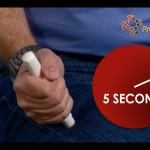
The features of this unit are:
- That it has a longer needle to ensure the drug is delivered in the correct place
- Offers a higher dose with units of 150, 300 and 500 mcg
- It also reduces costs and has the longest shelf life of the others available at 30 months
- There is no upper temperature restriction
- It may be kept cold but you should not allow it to be frozen
- It has needle protection following the injection and supplied in a durable plastic case for protection when carrying or storing
- There is no need to check the adrenaline as the Emeradehas a peel-back label that covers the inspection window, protecting the adrenaline from light.
The unit is used in a similar way to other units but there are a few differences.
With the Emerade auto-injector, we are now going to look at what the manufacturer states is better with their unit. The reason the Emerade has been developed is to meet the recommendations of UK Resuscitation Council’s Guidelines for Healthcare Providers who recommend that a 500 mcg for most patients above 12 years and this unit is available at this level, which may reduce the need of a second auto-injector.
Other brands of auto-injectors are available in150 and 300 mcg dose. The recommended adrenaline dose for the treatment of anaphylaxis is 5-10 mcg/kg. Therefore, a 300 mcg dose is too low for most adults so medical professionals can prescribe the Emerade 500 to meet these recommendations.
For an Intra Muscular injections, the UK Resuscitation Council guidelines for healthcare providers recommend a 25 mm needle for all ages. For small infants, a 16 mm needle is suitable. Other auto-injectors only have needle lengths of 12.5–16.5 mm which the manufactures state may be too short for many adults and children. Based on needle length only, up to 61% of children above 30 kg and up to 54% of women would not receive an IM injection with 12.5-16.5 mm needles.
The Emerade is fitted with a 25 mm needle for the 500 and 300 mcg dose and a 16 mm needle for the 150 mcg dose. Emerade’s longer needle ensures more patients receive an IM injection under similar circumstances compared to its opposition.
Although it has been suggested that the compression and expulsion force of auto-injectors may enable subcutaneous injections to enter the muscle, this has never been demonstrated in humans. There is connective tissue separating the subcutaneous and muscle compartments. To guarantee an effective IM injection, the needle should reach the muscle.
